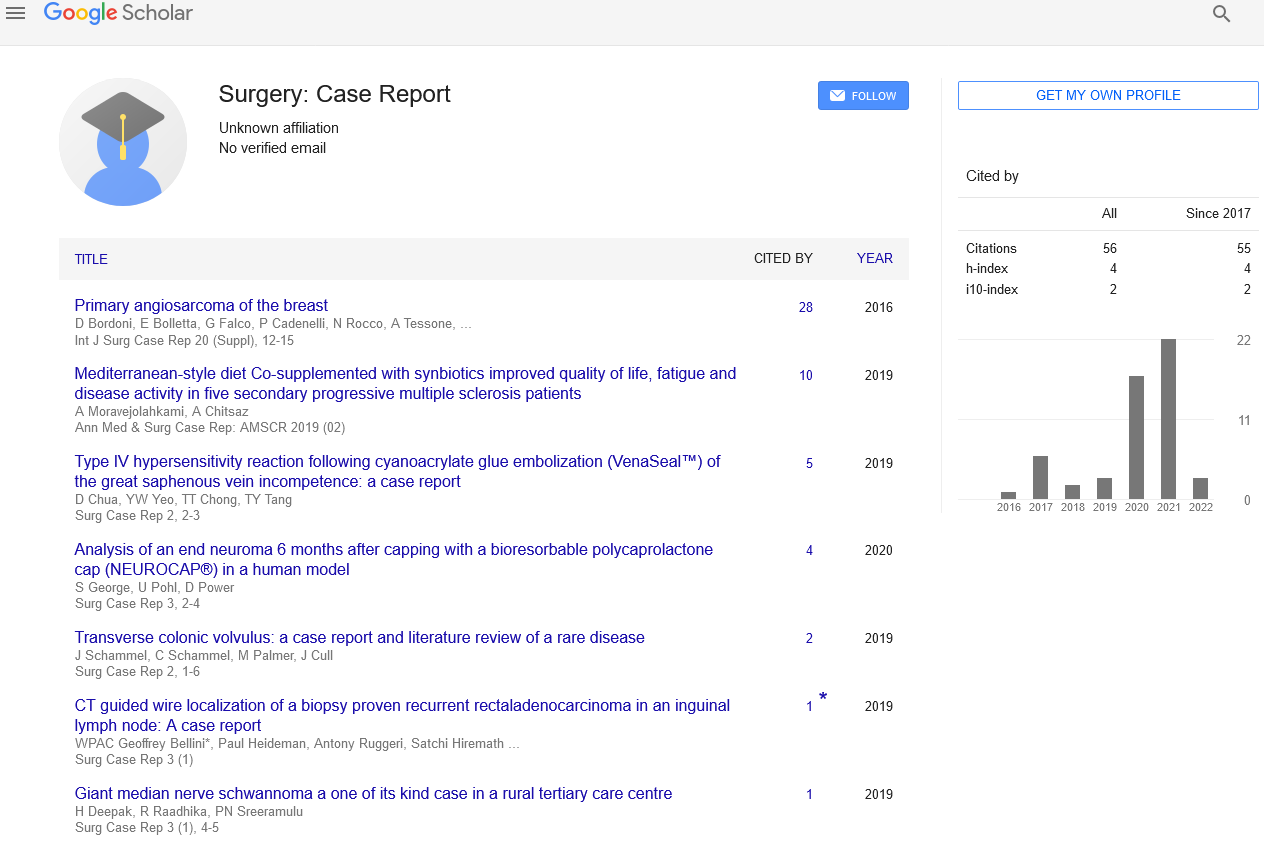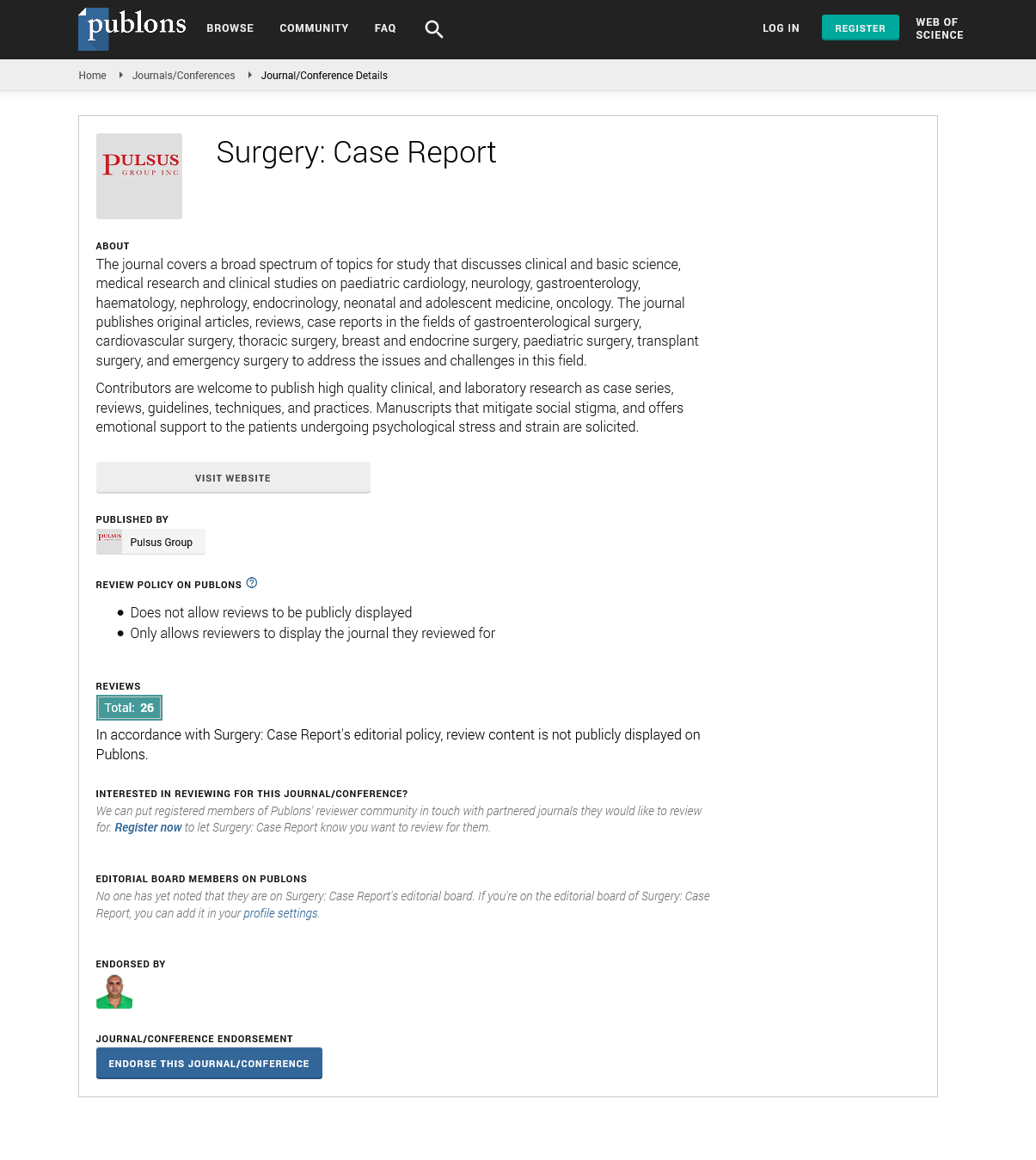Stage two lung cancer therapy approaches
Received: 15-Nov-2021 Accepted Date: Nov 20, 2021; Published: 25-Nov-2021
Citation: Green OL. Stage two lung cancer therapy approaches. Surg Case Rep. 2021; 5(6):1.
This open-access article is distributed under the terms of the Creative Commons Attribution Non-Commercial License (CC BY-NC) (http://creativecommons.org/licenses/by-nc/4.0/), which permits reuse, distribution and reproduction of the article, provided that the original work is properly cited and the reuse is restricted to noncommercial purposes. For commercial reuse, contact reprints@pulsus.com
Editorial
When a tumour has grown to a specific size or has gone beyond the lungs and into the lymph nodes; it is classified as stage 2 lung cancer. A person with stage 2 lung cancer will require different therapy than someone with a different stage of lung cancer. When cells in particular regions of the lungs and airways proliferate and divide out of control, lung cancer develops. The respiratory system includes the lungs. The organs and tissues of the respiratory system let a person take in oxygen and expel carbon dioxide. Air enters the nose or mouth and passes via the trachea to smaller airways called bronchi when a person breathes. Bronchi split into bronchioles, which are branch-like tunnels in the lungs that lead to air sacs called alveoli. Lung cancer develops in the cells that line the bronchi and other smaller airways, as well as specific areas of the lung, such as the bronchioles and alveoli. Lung cancer is divided into two types: small cell lung cancer (SCLC) and non-small cell lung cancer (NSCLC). NSCLC is the most prevalent form; accounting for 80–85 percent of all cases Oncologists. NSCLC is divided into four stages by doctors to illustrate how far the disease has progressed. A doctor examines the tumour size, whether the cancer has spread, and where it has gone to when determining the stage of NSCLC. The stage of cancer also aids doctors in determining which treatment choices a patient requires and their prognosis. Stage 2 NSCLC is divided into two substages by doctors: 2A and 2B. At stage 2, the tumour is more than 4 cm in diameter, or the cancer has spread to adjacent lymph nodes or other tissues according to oncologists.
Healthcare workers may refer to stage 2 NSCLC as early stage NSCLC, according to various cancer researches. In addition, it’s possible that a portion of the damaged lung has collapsed. SCLC spreads and expands more quickly than NSCLC; accounting for 10–15 percent of all cases Oncologists. In addition to utilizing the numerical staging approach, doctors often describe kinds of SCLC as restricted stage or extended stage. The tumour in stage 2 A NSCLC measures 4–5 cm, according to the National Cancer Institute (NCI) oncologists. The malignancy has not spread to the lymph nodes at this time. Furthermore, stage 2A might denote the following: Intraoperative fluorescent molecular imaging is critical in establishing unambiguous efficacy studies and is required to improve clinical practice. Following this stage, further substantial expenditures are anticipated in new tracers with enhanced pharmacokinetics and specificity, and more advanced image processing tools. The relative simplicity through which fluorescence imaging may be integrated into the practice of several different surgical and interventional situations is a major advantage of the technology, necessitating the need for centres of competence to teach users and raise awareness of the method.
• The tumor has progressed to the deepest layer of the lung membrane.
• The carcinoma advanced to the major bronchus but not to the carina, where the windpipe divides into the bronchi, resulting in partial or complete lung collapse.
• Pneumonitis has affected all or part of the lungs.
• The tumour has grown more than 5 centimeters (cm) in size or has expanded to the first level of local lymph nodes on the same side as the tumour, according to the NCI Oncologists.
In addition, one or more of the following characteristics may be discovered by a doctor:
1. Cancer that develops in the inner layer of the lung’s membrane
2. Pneumonitis has occurred or the lung, or a portion of it, has collapsed.
3. Carcinoma of the major bronchus but not the carina.
A doctor may also find that the cancer has not progressed to the lymph nodes. They could come across one or more of the following in this case:
• The tumour is 5–7 cm in diameter.
• In the same lobe of the lung as the main tumour, one or more other tumors’ have formed.
• One or more of the following locations have been affected by the cancer:
• The sac surrounds the heart’s outer layer of tissue
• The inner membrane of the chest wall
• The sternum wall
Most patients with lung cancer will not notice symptoms until it has spread, according to oncologists. The following are some frequent symptoms that may suggest lung cancer when they occur:
• Coughing up blood or phlegm that is rust-colored
• Hoarseness caused by a cough that does not go away or worsens
• When breathing heavily, laughing, or coughing, chest discomfort may develop or become worse.
• Reduction of appetite and weight loss without explanation
• Feelings of weakness or exhaustion from recurring lung infections, such as pneumonia or bronchitis
• Wheezing and lack of breath
It’s crucial to remember that while these symptoms might suggest lung cancer, they could also signal a variety of other, less serious problems. If a person with stage 2 NSCLC is well enough, they can have surgery to remove the cancer, according to the cancer surgeons. A lobectomy or sleeve resection will be performed by a surgeon. They may do a pneumonectomy, which is the removal of the whole lung, in some situations. They will also remove any lymph nodes that are impacted, which will aid in the planning of the following steps in therapy. If cancer cells are discovered around the borders of the excised tissues, the patient may require further surgery and chemotherapy. A person may additionally undergo atezolizumab immunotherapy for up to a year. A healthcare practitioner may propose osimertinib as a targeted medication treatment for patients with EGFR-positive lung cancer. Radiation therapy, with or without chemotherapy, may be the primary therapeutic option for people who cannot or do not want to undergo surgery.
As a general indication, the oncologists give an estimated 5-year relative survival rate for lung cancer. A relative survival rate estimates how long a person with a certain ailment will survive after obtaining a diagnosis in comparison to those who do not have the condition. If the 5-year relative survival rate is 70%, it signifies that a person with the ailment has a 70% chance of living for 5 years as someone who does not have the condition.
Researchers have utilized the SEER database, and there by categorized the tumours’ into the following stages:
Localized: Refers to the fact that the cancer has not spread beyond the lung.
Regional: The cancer has progressed outside of the lung to neighbouring lymph nodes or structures at this time.
Malignant: Cancer has spread to other regions of the body, including the brain, liver, bones, and other lungs.
Localized NSCLC has a 5-year relative survival rate of 63 percent, whereas regional NSCLC has a 5-year relative survival rate of 35 percent. Stage 2 lung cancer straddles the line between the two, with a predicted survival rate somewhere in the middle.
In recent years, it appears that overall survival has improved. It’s crucial to keep in mind that these are estimations. A person can seek advice from a medical specialist regarding how their disease will impact them. If a person has any strange symptoms, they should consult a doctor. A doctor can assist in determining what underlying reason is causing the symptoms. A physical examination and discussion of the patient’s medical and family history are expected. A person’s doctor may decide that cancer must be ruled out. They may order tests for lung cancer, such as: biopsy, which is the removal and examination of a small sample of tissue from the lungs sputum cytology, which is the examination of mucus from the lungs imaging tests of the lungs, such as PET, MRI, CT scans, or X-rays bronchoscopy, which is the insertion of a tube to check for tumours or take a biopsy thoracentesis.
There are a variety of tools available to assist a person or a family member cope with a cancer diagnosis. The doctors have a number of services to assist with a variety of issues, including finding support groups. On their website, a user may look for various supports group alternatives. A person’s doctor or healthcare team may also be able to give information about support groups and other services. A person should seek assistance from a trusted member of their treatment team in locating resources that may be beneficial to them. Here’s additional information on how to deal with a cancer diagnosis. The term “stage 2 lung cancers” refers to a specific stage of non-small cell lung cancer (NSCLC). The cancer has either not gone beyond the lungs or has only migrated to the first level of nearby lymph nodes at this stage. Surgery, chemotherapy, immunotherapy, targeted medication treatment, radiation, or a combination of these is used to treat cancer. Stage 2 lung cancer has a 5-year relative survival rate of 35–63 percent. Though these figures may continue to improve according to oncologists in order to cope with a cancer diagnosis, a person may find it helpful to join a support group.






